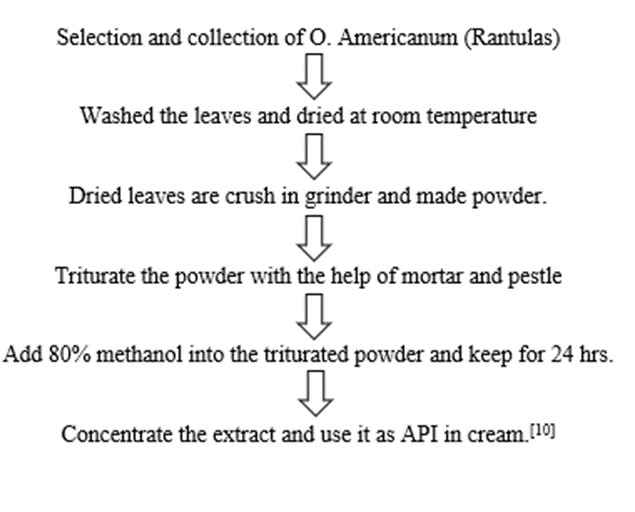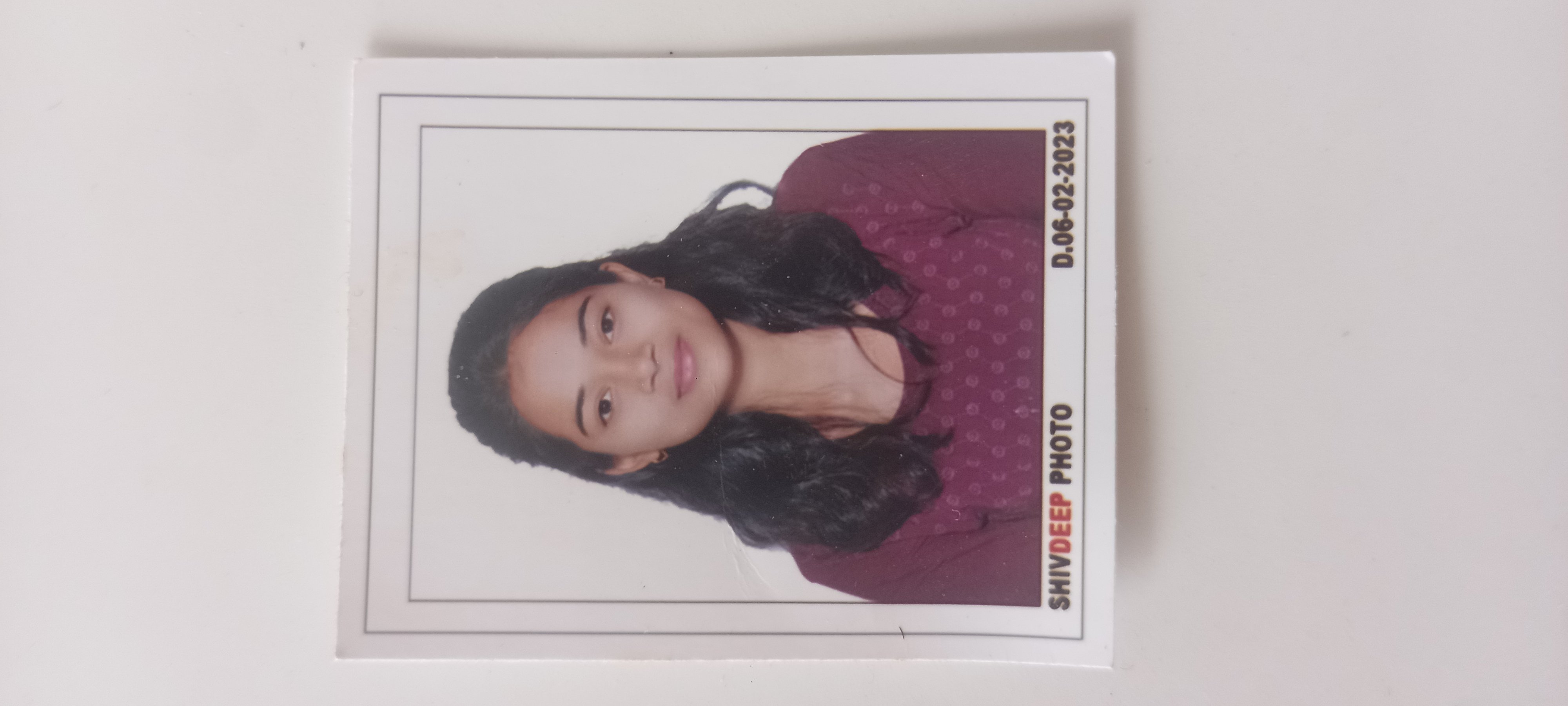Abstract
The aim of delivering herbal medicine is to control human disease efficiently. The WHO reports that 80% of the world's population currently receives their primary care from herbal medicine. A type of cream called antifungal cream is used to eradicate and prevent the growth of fungi. This study aims to explore the safety and efficacy of prepared antifungal cream and to manufacture a cream that does not show any unwanted responses or side effects. The lamiaceae plant Ocimum Americanum L., sometimes known as lantulas, was utilised to make the mixture that was utilised in this investigation to control fungal infections. The main components of O. Americanum include terpineol, methyl chavicol, eugenol, and linalool. Volatile oils found in plant leaves contain a wide range of pharmacological characteristics, such as antibacterial, antioxidant, anthelmintic, and antifungal effects. Method: After storing this mixture for a full day, the powder in 80% methanol was extracted using filtration. This extract can be evaporated in a water bath to make it semi-solid. Then, use the semi-solid extract to make a cream base formulation. The primary emphasis of this investigation is O. Americanum's antifungal activity.
Keywords
Fungal infections, Cream, Herbal, Ph, Ringworm, Jock itch
Introduction
Indian herbs are widely recognised for their diverse applications across the globe. Natural cosmetics made from herbs are a precious gift from nature that are in great demand worldwide. Herbal formulations have always attracted a lot of attention because of their good activity and negligible or nonexistent adverse effects when compared to synthetic medications. Herbal cosmetics have favourable physiological activities, such as healing, smoothing appearance, boosting, and conditioning qualities, because they contain herbal elements. Because more and more herbs are being used to make cosmeceuticals for personal care systems, there is a present need for herbal cosmetics. Using synthetic chemicals over time may have detrimental effects on youth and the environment. A plethora of synthetic materials, chemicals, dyes, and their byproducts have been demonstrated to induce a diverse array of skin ailments along with an abundance of unfavourable consequences. We therefore employ herbal products whenever possible. The medicinal systems of homoeopathy, unani, and ayurveda also provide descriptions of skin care items. These are the various items made with crude or extract forms of herbs. Herbal medicine is among the most traditional and extensively utilised kind of healthcare. The administration of herbal medications with the aim of successfully treating human ailments has advanced recently. The World Health Organisation (WHO) estimates that 80% of the world's population currently uses herbal medicine for primary care. Herbal treatments are used as a self-medication method for healthcare in every country. Clinical experience, traditional wisdom, understanding of medical science, and scientific validation of herbal therapy form the basis of modern herbal medicine. People are gradually shifting to alternative and complementary therapies.[1,2]

Fig No 1: Types Of Fungal
FACTORS AFFECTING FOR FUNGAL:
- PH
- Temperature
- Photoperiod, light intensity
- 4.Atmospheric gases
- Strain variability
- Inoculum size
- Competing microflora[3]
FUNGAL TREATMENT:
Treatment with fungi to treat different types of fungal infections, a variety of preparations for fungal treatments are available. They are available as injectables, tablets meant to be inserted into the vagina (pessaries), sprays, solutions, lotions, and pills for oral use. Fungal Treatment: What is it 03 The kind and severity of your fungal infection, together with any other medical conditions, will determine how long your therapy will take. Certain treatment regimens, like those for vaginal thrush, can be completed in a matter of days. Some regimens (like those for scalp ringworm infections) might last up to eight weeks. Most function by causing damage to the fungus's cell wall, which results in the fungal cell dying. How to handle fungal infections. Topical antifungals, such as creams, liquids, or sprays These are applied to the skin, scalp, and nails to treat fungal infections. Clotrimazole, terbinafine, amorolfine, miconazole, ketoconazole, econazole, and miconazole are a few of them. They are available under a variety of brand names. When two activities are needed, an antifungal cream is occasionally used with other treatments. For instance, to treat specific rashes, an anti-fungal cream and a moderate steroid cream, such hydrocortisone, are frequently mixed. The moderate steroid cream lessens the inflammation brought on by the illness, while the antifungal cream eradicates the infection.[4]
Plant profile:
Tulsi leaves
Biological name :
Ocimum sanctum L.
Biological source:
Tulsi consists of the fresh and dried leaves of Ocimum species like Ocimum sanctum L.
family :
Lamiaceae.
CHEMICAL CONSTITUENTS :
The leaves of ocimum sanctum contain 0.7% volatile oil comprising about 71% eugenol and 20% methyl eugenol. The oil also contains carvacrol and sesquiterpine hydrocarbon caryophyllene. Two flavonoids orientin and andvicenin from aqueous leaf extract of ocimum sanctum have been isolated.[5,6]
Uses:
- Lowers Stress and Anxiety.
- Stimulates and Vitalises Your Body.
- Lower Your Blood Sugar.
- Lowers Cholesterol.
- Easing Inflammation and Joint Aches.
- Secures Your Stomach.
- Protection Against Wounds and Infections.
- Helps in Relieving Kidney Stones.
- Tulsi is rich in antioxidants and has anti-inflammatory properties, which makes it effective in treating various ailments such as colds, coughs, and respiratory infections.
- It is also believed to boost the immune system, improve digestion, and reduce stress levels
- Cleanses pores deeply Lead fighter of anti-acne club
- Prevents early signs of ageing
- Skin shines like a sunshine
- A perfect moisturizer that skin truly needs.[7]

Fig No 2: Tulsi Leaves
MATERIALS AND EQUIPMENTS:
Table No 1: Ingredients [8,9]

Extraction Of Active Ingredient:

Procedure:


Fig No. 3

Fig No.4
Evaluation of anti-fungal cream :
1. Physical properties:
The Cream was observed for the colour ,odour , and appearance .
Table No 2:

2. Determination of pH:
The pH of various formulation was determined by using digital pH Meter. The 0.5g of the weighed formulation was dispersed in 50ml of distilled water.
PH Test:
Table No 3:

3. Spreadability Test:
The device used to measure spreadability consisted of a wooden block with a pulley at one end. This approach examined spreadability based on the ointment's slide and drag properties. On the ground slides, an excess of the ointment under investigation (about 2 grams) was applied. After that, the ointment was positioned with the hook between this glass slide and another one that had the same dimensions as a fixed ground slide. For five minutes, a one kilogram weighted was placed on top of the slides to release air and create a consistent layer of ointment between the slides. The excess ointment was removed by scraping off the edges. The top plate was then subjected to pull of 80 gm. With the help of string attached to the hook and the time
4. Washability Test:
0.5 gm of prepared formulation was applied on the skin. And it was washed with luke warm water. The time taken for removal of preparation was noted.
5. Irritancy test:
Mark an area of 1sq cm on the left had dorsal surface. The cream was applied to the specified area and time was noted. Irritancy erythema, edema was checked if any for regular intervals upto 24 hrs and reported.
6. Homogeneity:
The formulation was tested for the homogeneity by visual appearance and by touch.
7. Test for microbial growth in formulated creams:
Using the streak plate method, the prepared creams were inoculated into agar medium plates, and a control was created by leaving out the cream. The plates were put in the incubator and left there for a whole day at 37 OC. Plates were removed from the incubator after the incubation period to assess microbial growth by contrasting it with the control.[11,12]
RESULTS:

CONCLUSION
A great deal of research is being done in this area because a large proportion of the world's population still receives their medical needs from herbal treatments in underdeveloped countries. The primary goal of this study is to determine whether plant extracts have any promise for use in medicine. •The generated formulation showed good consistency, no phase separation, and satisfactory spredability during the course of the testing period. • Reliability Parameters such as nature diversity and appearance did not change much during the study period.[13]
REFERENCES
- C.k. Kokate: A.P Purohit: S.B. Gokhale; Textbook Of Pharmacognocy; Nirali Prakashan; 15th Edition; Sept., 2014; 16.67- 16.68.
- Deosarkar S.S; Khedkar C.D: Kalyankar S.D: Sarode A.R: The Encyclopedia Of food And Health. Volume-2.Oxford Academic Press, 2016; 331-332.
- https://www.slideshare.net/slideshow/physical-factors-affecting-the-growth-of-fungipptx/251859735
- https://thomsonspecialistskincentre.com/our-services/medical-dermatology/fungal-infections/
- Uma Devi P. Radioprotective, anticarcinogenic and antioxidant properties of the Indian holy basil. Ocimum sanctum (Tulasi). Indian J Exp Biol. 2001:39:185-190.
- Gupta, S.K, Prakash J and Srivastava S. Validation of traditional claim of Tulsi, Ocimum sanctum Linn. as a medicinal plant. Indian J Exp Biol. 2002:5:765-773.
- https://www.tataaig.com/knowledge-center/health-insurance/health-benefits-of-tulsi-leaves
- 2. Deosarkar S.S; Khedkar C.D; Kalyankar S.D; Sarode A.R; The Encyclopedia Of food And Health,Volume-2,Oxford Academic Press, 2016; 331-332.
- More B.H; Sakharwad S.N; Tembhurne S.V; Sakarkar D.M; Evalution For Skin Irritacy Testing Of Developed Formulations Containing Tulsi Oil For Its Topical Application, International Journal Of Toxicology And Pharmacology, 2013; 10-13.
- Nakamwi Akombaetwa, Lungwani Tyson Muunga, James Nyirenda, Sergio Muwowo. Formulation And Assesment of the Efficacy And Stability of an Ointment containing O. Americanum l. extract. Clinical Complementary Medicine and Pharmacology 3 (2023)
- Powar. A. D., & Nitave, S. A. (2022). A REVIEW-POLYHERBAL ANTIFUNGAL CREAM.
- Sumathi A: Senthamari R.: A Review on Harbal Medicines and Drug Technology Asia. J.Pharm. Health Science, 2015; 1172-1173.
- Tuwar A.R., Tuwar D. A. Preparation of Herbal Formulation from leaves of O. Americanum and Eclipta alba and it's efficiency against the Fungal Diseases and wound in Dairy Animals. Journal of the Maharaja Sayajirao University of Baroda ISSN-0023-0422


 Pawar jagruti prakash *
Pawar jagruti prakash *
 More prasad sunil
More prasad sunil
 More Lankesh Rajaram
More Lankesh Rajaram
 Zahid Anwer Ansari Shahid Ahmed
Zahid Anwer Ansari Shahid Ahmed










 10.5281/zenodo.12736870
10.5281/zenodo.12736870